wafflejock
Well-Known Member
So there are two distinct places you can have two antenna, on the transmitting side and on the receiving side.
On the TX/Transmitting side if you split an already amplified signal in half like you said basically half the power is going to one antenna and half the power is going to the other antenna. I haven't really worked with any setups that have multiple transmitting antenna I think in most cases you are best off getting a higher powered transmission from single antenna rather than adding another transmitting antenna at the same location. There may be cases like a ground station where it makes sense to have multiple directional outgoing/transmitting antenna (thinking of cell towers with all those directional rectangular looking transceiver antenna, a transceiver just does both transmit and receive, usually not at exactly the same time but can flip flop and utilize the same antenna for both).
Regarding the second half and having two antenna on the receiving side, this is what a "diversity" module is for, check out "rapid fire" from immersionRC or "LaForge V4" (or whatever latest version is). Basically these receivers take two antenna inputs and they "check" to "see" which one has the strongest signal, whichever one has the strongest signal gets passed along to the receiver signal amplification/filtering circuit and from there the video signal is passed along to the display/output. I think rapid fire actually somehow combines the signals whereas laforge just quick switches between them (you can see the change in vid quality and hear it click when it changes, can also display on screen what signal strength each antenna is getting and some other things)
On the TX/Transmitting side if you split an already amplified signal in half like you said basically half the power is going to one antenna and half the power is going to the other antenna. I haven't really worked with any setups that have multiple transmitting antenna I think in most cases you are best off getting a higher powered transmission from single antenna rather than adding another transmitting antenna at the same location. There may be cases like a ground station where it makes sense to have multiple directional outgoing/transmitting antenna (thinking of cell towers with all those directional rectangular looking transceiver antenna, a transceiver just does both transmit and receive, usually not at exactly the same time but can flip flop and utilize the same antenna for both).
Regarding the second half and having two antenna on the receiving side, this is what a "diversity" module is for, check out "rapid fire" from immersionRC or "LaForge V4" (or whatever latest version is). Basically these receivers take two antenna inputs and they "check" to "see" which one has the strongest signal, whichever one has the strongest signal gets passed along to the receiver signal amplification/filtering circuit and from there the video signal is passed along to the display/output. I think rapid fire actually somehow combines the signals whereas laforge just quick switches between them (you can see the change in vid quality and hear it click when it changes, can also display on screen what signal strength each antenna is getting and some other things)



